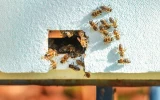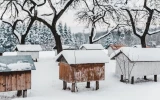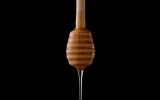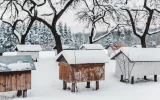The Ultimate Guide To Beekeeping in Winter & Cold Climates
Beekeeping in winter and cold climates can be challenging, as you'll need to provide extra attention and care to your bees during this time to ensure their survival and productivity. It can be a rewarding experience with the right knowledge and preparation. Let's get you to successfully navigate the unique challenges that winter beekeeping presents and enjoy a thriving colony all year round with this guide.
Winter beekeeping requires ensuring that your bees have the necessary resources and protection to survive, that your hive has a large population of bees, is well stocked with pollen, is well insulated, and has an internal heat source if temperatures drop below freezing. Monitor your hives to ensure they have enough food and check for signs of dampness or pests.
In this guide, we'll explore the essential tips and techniques for successful beekeeping during the colder months. From selecting the right bee species for your climate, to maintaining optimal hive conditions, and employing effective winterization strategies, you'll gain the necessary knowledge to confidently care for your bees even in the harshest of conditions.
Summary
- Beekeeping in winter is definitely challenging, but with proper planning, care, and knowledge, you can help your bees thrive and ensure a healthy and productive colony when spring arrives.
- As you venture into the world of winter beekeeping, remember that your dedication and attention to detail will play a crucial role in your hive's wellbeing.
- By remaining proactive and informed, you can ensure a healthy colony that continues to flourish despite the challenges that cold weather brings.
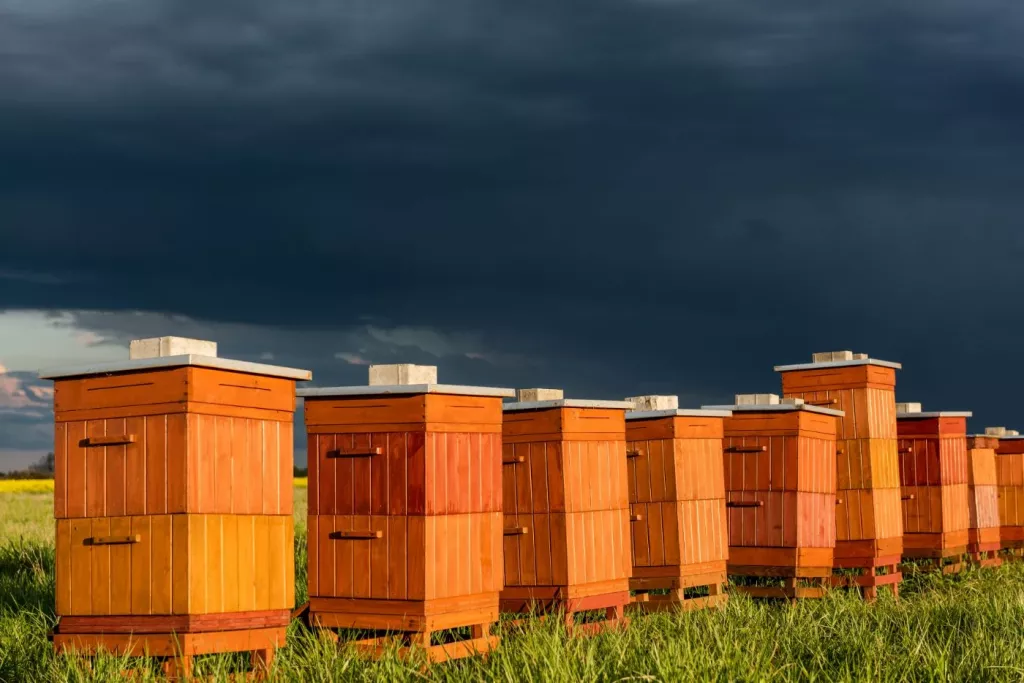
On this page:
In-Depth Guide to Beekeeping in Winter
As a beekeeper in winter and cold climates, your primary responsibility revolves around proper hive management, feeding, and precautions against pests like the Varroa mite. Before winter sets in, assess your beehive's weight to determine if it has adequate honey reserves. If not, consider providing supplemental feeding, such as sugar syrup or fondant.
During winter, you may notice that your bees cluster around the queen for warmth and protection. This is a natural behavior that helps them survive the cold temperatures. To further assist them, you can insulate the hive and ensure proper ventilation to reduce condensation and maintain a suitable temperature inside.
Joining a local beekeeping club can be beneficial, as it allows you to connect with fellow beekeepers and exchange valuable knowledge and experience about effective winter beekeeping practices specific to your area.
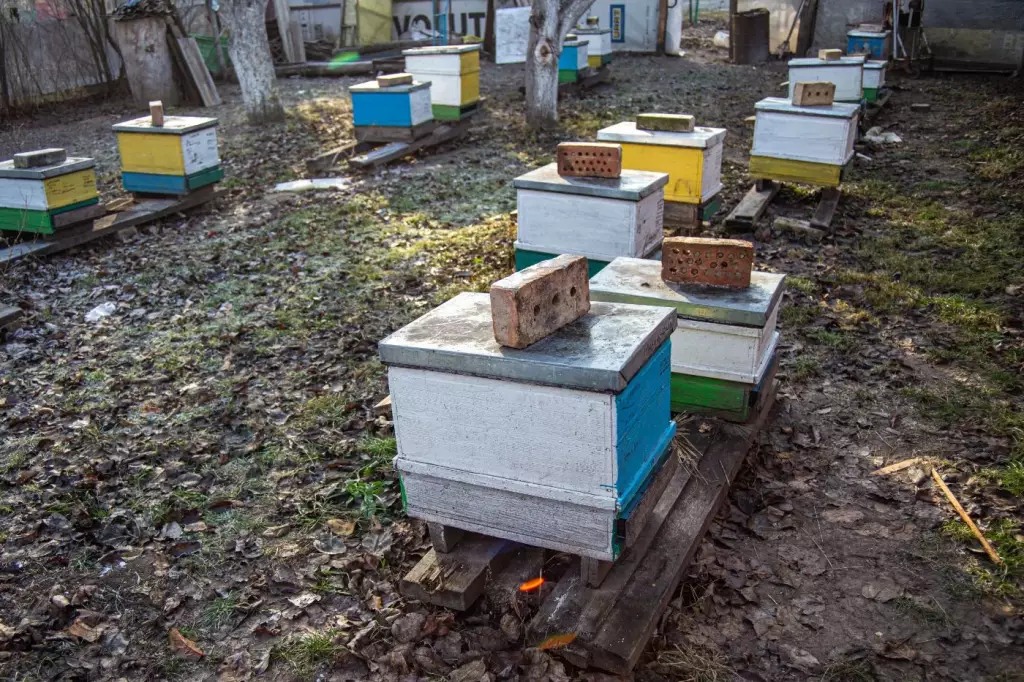
When it comes to beekeeping in cold climates, you'll encounter various challenges that can impact the health and survival of your honeybee colonies. In this section, we will explore some critical factors to be aware of and help you better understand winter beekeeping hurdles.
Temperature regulation of your beehives
Honeybees are one of the few insect species that can survive winter conditions without becoming completely dormant. Temperature regulation is crucial for the survival of the colony. In colder months, bees huddle together in a cluster to maintain their internal temperature and protect their queen. They vibrate their wings and bodies to generate heat, which is essential for their well-being.
As a beekeeper, your role is to support your colonies in maintaining their temperature during the winter. It's vital to provide insulation and ventilation to your hives to aid the bees in this process. You should also check for drafts or cracks in the hive boxes and repair any damages before winter arrives.
Food resources for your bees
During the winter, the availability of natural resources such as nectar and pollen decreases significantly. This limited food supply poses a challenge for honeybee colonies, as they rely on these resources to survive.
To tackle this issue, you need to ensure that your colonies have adequate food stores heading into the winter months. This means providing them with supplementary sugar syrup and pollen patties, if necessary, to assist them in sustaining their energy levels throughout the season.
Monitoring the weight of your hives is also essential for gauging when additional feeding may be required. Remember, a healthy colony is less susceptible to diseases and winter losses.
Moisture control of your beehives
Managing moisture in the hive is another essential aspect of winter beekeeping. Excess moisture can lead to mold growth or cause the bees to freeze, ultimately harming the colony. Proper ventilation is critical in preventing moisture buildup and maintaining a balanced environment within the hive.
You can achieve moisture control through various methods, such as installing upper vents, adding moisture-absorbing materials like wood shavings, or using an insulated inner cover. Regularly monitoring the interior conditions of your hives will provide you with valuable information on whether your moisture control techniques are effective.

Preparing the Beehive for Winter
As the cold season approaches, it is vital to take several steps to ensure your beehives remain healthy and productive. In this section, we will discuss the necessary preparations for your beehives, including inspecting the hive, reducing its size, insulating, and managing ventilation and moisture.
By following these guidelines, your beehive will be well-prepared to withstand the winter months and ensure a healthy, thriving colony come springtime.
Inspecting the beehive for winter
Begin by examining the health of your hive. Look for signs of weakness or diseases, such as an unhealthy brood or a poorly performing queen. It is essential to address these issues before winter sets in, as they can severely impact the hive's ability to survive the cold months. This may involve requeening your hive or combining two colonies, if necessary.
Reducing the hive size before winter
During winter, bees cluster together to conserve heat. Reducing the size of your hive can help your colony maintain a comfortable temperature more efficiently. Remove excess frames and boxes, leaving enough room for the bees to cluster and still access their honey stores. Ensure the bees have enough stored food, including honey and pollen, to last them through the winter.
Insulating the hive before winter
Proper insulation can protect your beehive from harsh winter weather conditions. Depending on your location, you may need to provide additional insulation to help maintain an optimal temperature inside the hive. One option is to wrap the hive with insulation material or use a special beekeeping winter wrap. Consult your local beekeepers or beekeeping association for specific recommendations based on the average winter conditions in your area.
Ventilation and moisture management of beehives for winter
Managing moisture inside your beehive is just as important as maintaining proper insulation. Cold temperatures can cause condensation to form inside the hive, leading to damp conditions that are harmful to the bees.
To promote adequate air circulation and reduce moisture, create a small upper entrance for the bees, such as a notch in the inner cover or a tiny hole drilled in the hive body. You can also place a moisture-absorbing material, like wood shavings or newspaper, on top of the inner cover to help control condensation.
Feeding Bees in Cold Climates
In cold climates, feeding bees can become essential to the survival of the hive. It's important to provide them with the right nutrients and energy to stay alive and healthy during the winter months. In this section, we will discuss some common feeding methods and resources, such as sugar syrup, candy boards, and pollen patties.
Your primary goal when feeding bees in cold climates is to keep them well-nourished and healthy. Each hive's needs will vary, so monitor your bees closely, experiment with different feeding methods, and adapt as required.
Feed bees with sugar syrup
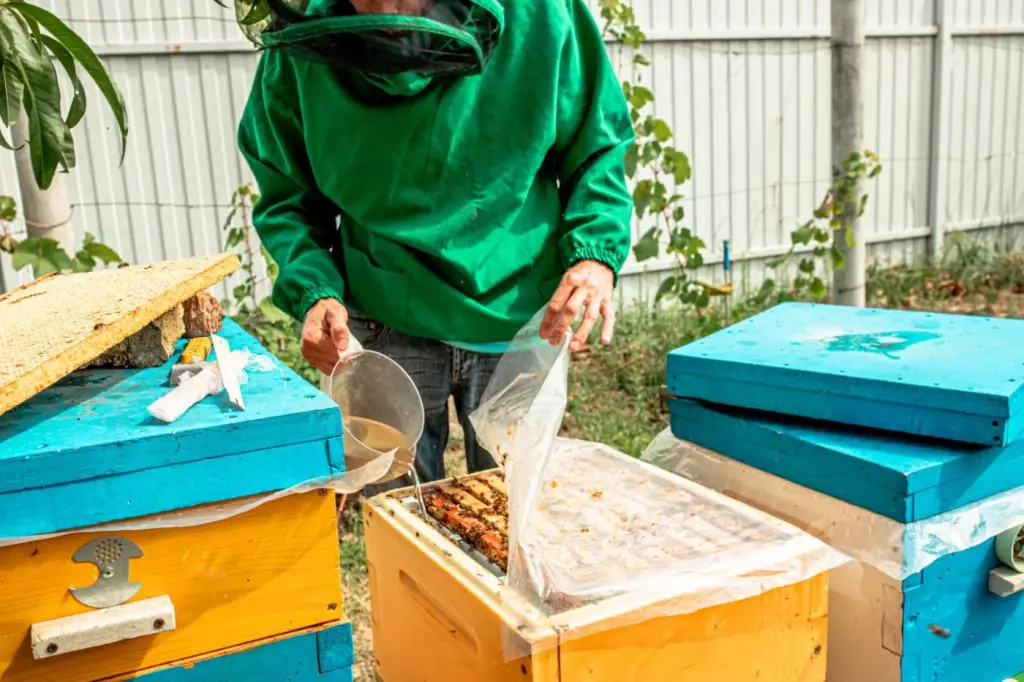
You can feed your bees sugar syrup, which is simply made by mixing sugar and water. In colder months, it's recommended to use a thicker syrup with a 2:1 ratio of sugar to water. This prevents the bees from storing excess moisture, which could lead to issues with mold in the hive.
To feed your bees sugar syrup, you can use a top feeder or an entrance feeder. Keep in mind that liquid feed is not suitable for the coldest period of winter, as bees might not break their cluster to feed on the syrup. In this case, switch to a different type of feed, such as candy boards or pollen patties.
Feed bees with candy boards
Candy boards are a popular option for feeding bees during extreme cold weather. They are made with sugar, water, and sometimes corn syrup or other ingredients. Candy boards provide a stable source of carbohydrates for the bees without increasing the moisture in the hive.
Adding a candy board on top of the hive is easy, and the bees can feed on it when they need additional food sources. Don't forget to check the candy board regularly and replace it when it becomes depleted.
Feed bees with pollen patties
Last but not least, you have the option of feeding bee pollen patties as supplemental winter nutrition. Pollen patties are made with a mix of bee pollen, sugar, and sometimes additional proteins and vitamins. They help provide the essential nutrients needed to keep the colony healthy and disease-free throughout the winter.
Place the patties directly on the top bars of the hive so the bees can easily access them. Monitor the consumption of pollen patties and replace them as needed.
Monitoring and Protecting the Beehive for Winter
In winter and cold climates, safeguarding your honeybee hive requires careful monitoring and protection. This section will guide you through the process of conducting periodic check-ups, controlling pests and predators, and staying alert for diseases.
By giving your bees the proper care and protection they need, you'll see them through the winter season, ensuring they remain healthy and productive when the warmer weather returns.
Periodic check-ups of beehives for winter
Regular inspections play a crucial role in maintaining hive health during the winter months. As bees consume their stored honey, it's essential to check on their food supply periodically. Cold climate hives should have 80–90 pounds of honey, while warmer areas may require just 35 pounds.
When conducting these check-ups, do so on mild days, being cautious not to disturb the cluster of bees inside. It's essential to keep the hive well-ventilated and free from excess moisture that may lead to mold, mildew, or condensation issues.
Pest and predator control on beehives for winter
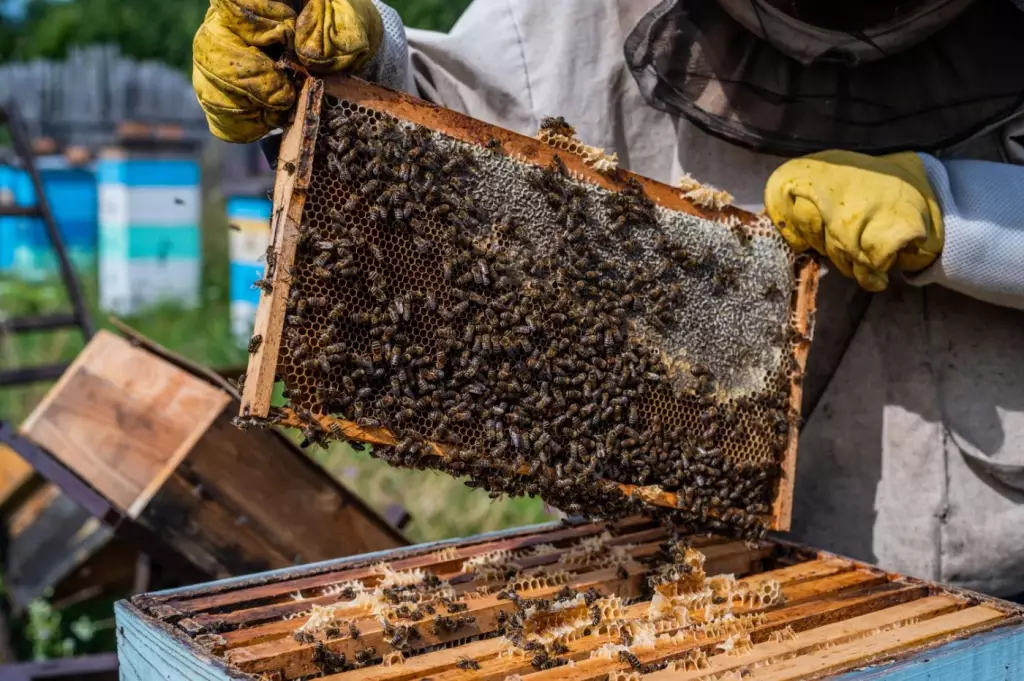
During winter, hives become a target for various pests and predators. To protect your bees, ensure their hive is elevated and that any openings are sealed to prevent intruders.
- Recognize signs of mice, such as chewed frames or droppings, and install mouse guards to deter them from entering the hive.
- Keep an eye out for wax moths, whose larvae can consume the hive's honeycomb. Remove any infected frames and freeze them to kill off the moth larvae before returning them to the hive.
- Defend against larger predators, such as bears or raccoons, by installing fencing or electric barriers around your apiary.
Staying alert for bee diseases in winter
Bee diseases can be detrimental to your hive, especially during the winter months when the colony has limited resources to recover. Learn to recognize signs of common diseases like Nosema or American Foulbrood and monitor your bees regularly for any symptoms.
If you notice signs of illness or infection, consult with experienced beekeepers or contact your local beekeeping association for advice on treatment options. Remember, prevention is more effective than cure, so always maintain a clean and healthy environment for your bees.
